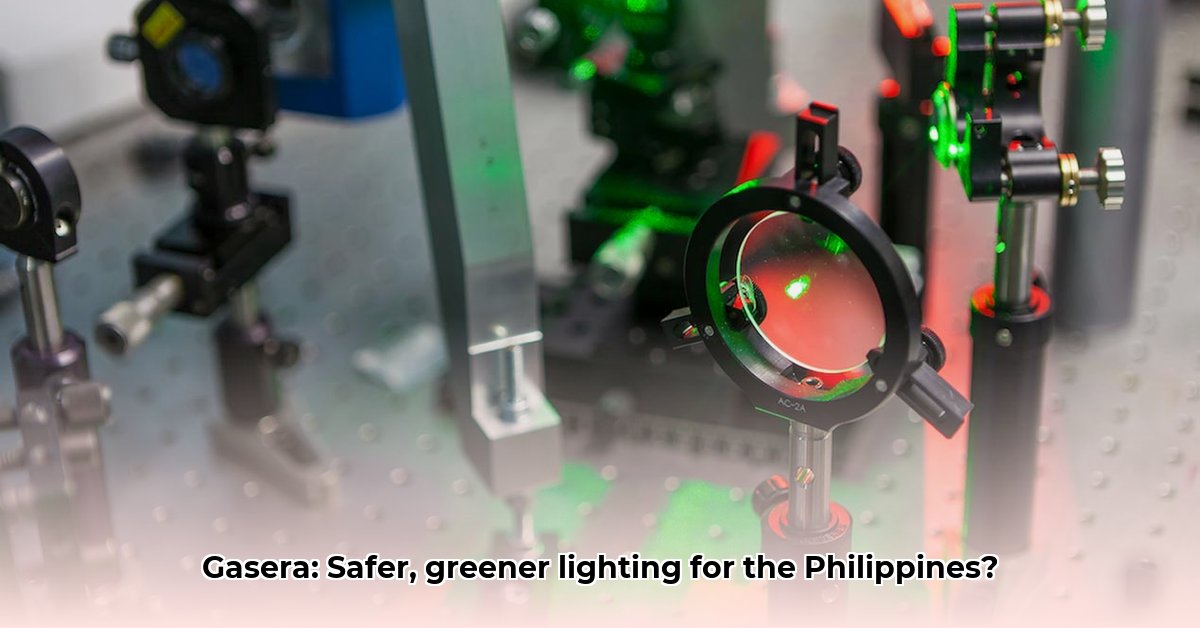“`markdown
Discover What Gasera Is: Safer, Sustainable Lighting Solutions for the Philippines
Imagine a time before widespread electricity, when a simple kerosene lamp, the gasera, was often the sole light source in a Filipino home. More than just illumination, it represented warmth, family, and stories shared in the evening’s glow. However, this familiar object also posed dangers: fire hazards, toxic fumes, and environmental harm. This article explores the gasera: its history, its role in Filipino life, and the critical need for safer, cleaner alternatives. We’ll examine its past, address the problems associated with kerosene lamps, and highlight innovative technologies and community solutions that promise a brighter, safer future for the Philippines. For more on sustainable energy solutions, see this relevant case study.
What Is Gasera? Illuminating the Philippines’ Past and Future with Renewable Energy
For many Filipinos, the question “What is a gasera?” once had a straightforward, nostalgic answer: a kerosene lamp. Often homemade from repurposed glass jars and fueled by kerosene, these lamps weren’t mass-produced items. They provided a warm, flickering light in countless homes, creating countless memories and showing the resourcefulness of a time before electricity was widely available. However, this seemingly simple device tells a more complex story than just illumination. It’s a story of ingenuity, inherent risks, and the continuous pursuit of safer, more sustainable energy solutions.
The Gasera: A Beacon of Filipino Ingenuity and Creativity
Consider the Philippine countryside decades ago, before the electric grid reached every corner. The gasera was a lifeline for families in remote areas against the encroaching darkness. Beyond just light, it symbolized hope and resilience. The gasera’s simple yet effective design demonstrated Filipino creativity. Families often built and repaired their own lamps, adapting designs and sharing knowledge across generations. They intimately understood how it worked, passing down the skills to make and maintain these essential light sources. The gasera was more than a lamp; it was a symbol of community and self-reliance.
However, this resourceful solution had significant drawbacks.
The Shadow of the Gasera: A Necessary Discussion on Kerosene Lamps’ Risks
While the gasera provided light, it also presented considerable risks. Kerosene, being highly flammable, led to numerous accidental fires and burns with tragic consequences. Beyond the immediate fire risks, the gasera contributed to indoor air pollution. The fumes released during combustion, containing harmful particulates, negatively impacted the respiratory health of many Filipinos, especially children and the elderly. Moreover, kerosene combustion contributed significantly to greenhouse gas emissions, worsening global climate change. While the gasera’s legacy includes ingenuity, it also took a significant toll on health and the environment, necessitating a shift towards safer, more sustainable alternatives.
A Brighter Dawn: Sustainable Lighting Solutions Emerge with LED Lighting
Fortunately, the lighting landscape in the Philippines is rapidly evolving. Innovations like the SALt (Sustainable Alternative Lighting) lamp, developed by the Mijeno siblings, represent a significant advancement. This lamp uses saltwater and readily available metals to produce light, eliminating the need for hazardous kerosene. It’s an excellent example of how human ingenuity can address energy poverty. Reduced environmental impact and lower long-term costs compared to kerosene make it a compelling alternative.
| Feature | Kerosene Gasera | Mijeno Saltwater Lamp |
|---|---|---|
| Fuel Source | Kerosene | Saltwater and readily available metals |
| Safety | High fire risk, emits toxic fumes | Significantly safer, no toxic fumes |
| Environmental Impact | High carbon emissions, contributes to air pollution | Minimal environmental impact |
| Cost | Low initial cost, ongoing fuel expense | Higher initial cost, very low operational cost |
| Maintenance | Regular refilling required | Electrode replacement needed, longer lifespan overall |
The Path Forward: Collaboration for Safe Lighting Solutions
Transitioning from gaseras to sustainable alternatives requires a collaborative approach. The Philippine government plays a vital role by expanding the electrical grid to reach underserved areas and supporting the development and production of innovative lighting technologies like the SALt lamp. Non-profit organizations (NGOs) are equally important, providing education and distributing safer lighting options within communities. Entrepreneurs and manufacturers can significantly contribute by scaling production and ensuring these sustainable solutions are accessible and affordable for all Filipinos.
Understanding “what is a gasera” and creating a brighter, healthier, more sustainable future for the Philippines is an ongoing process. It’s a journey driven by innovation, informed by an understanding of the past, and fueled by a collective commitment to a cleaner, brighter future. While challenges remain, progress indicates a future where everyone has access to safe, sustainable lighting. The gasera’s story highlights the importance of ingenuity and the continuous pursuit of better solutions.
How to Safely Build a DIY Gasera Lamp in the Philippines: A Step-by-Step Guide (With Safety Precautions)
Key Takeaways:
- The gasera, a DIY kerosene lamp, offers a low-cost lighting solution where electricity is scarce.
- Building a gasera involves repurposing common materials but demands strict adherence to safety.
- Kerosene’s flammability necessitates extremely careful handling and storage.
- Dim light output, health concerns, and environmental impact are significant drawbacks.
- Safer, sustainable alternatives are essential for long-term solutions and improved well-being.
Have you ever experienced a sudden power outage? The darkness descends, and the familiar hum of electricity vanishes. In the Philippines, where consistent access to reliable power isn’t always guaranteed, resourceful communities have long relied on a simple yet ingenious solution: the gasera, a DIY kerosene lamp. Let’s explore how to safely build a DIY gasera lamp in the Philippines, while emphasizing crucial safety measures and considering better lighting options.
Understanding the Gasera: A Symbol of Philippine History and DIY Lighting
The gasera represents more than just a lamp; it’s a symbol of resilience and Filipino ingenuity. For generations, Filipinos have adapted this simple design, using readily available materials to illuminate their homes and lives. Imagine the soft glow of a gasera on a warm evening, casting dancing shadows on the walls – a comforting presence during blackouts. However, this seemingly simple device must be treated with utmost respect due to the inherent dangers of kerosene.
Building Your Gasera: A Cautious Approach to DIY Home Lighting
This section emphasizes safety above all else. Remember, kerosene is extremely flammable. Improper construction or careless handling can lead to severe burns, fires, and other accidents.
Materials:
- A sturdy glass jar with a wide mouth is ideal for stability and ease of access.
- A non-flammable metal lid with a pre-drilled hole for the wick (a recycled metal can lid works).
- A tightly woven cotton wick or cotton strips, ensuring consistent fuel absorption.
- Kerosene fuel (store in a clearly marked, tightly sealed container away from heat and open flames).
- Sand or fire extinguisher, place nearby when handling kerosene.
Steps:
- Prepare the Wick: Cut a strip or tightly roll a piece of cotton cloth to create the wick. The length should allow it to extend comfortably into the jar and protrude slightly through the lid.
- Create the Wick Assembly: Carefully thread the wick through the hole in the metal lid, ensuring a snug but not overly tight fit. This will prevent kerosene leaks and control the flame.
- Fill the Jar: Slowly and carefully pour kerosene into the jar, leaving ample space (at least an inch) at the top to prevent spillage and allow for safe expansion.
- Light the Wick: Using a long match or lighter, carefully light the exposed part of the wick. Always do this in a well-ventilated area away from flammable materials. Keep a fire extinguisher, sand, or a bucket of water nearby in case of emergency.
- Use with Extreme Caution: The gasera is now providing light. Never leave a lit gasera unattended. Keep children and pets far away to prevent accidental knock-overs. Place the lamp on a stable, non-flammable surface away from curtains, paper, or other combustibles.
The Gasera’s Limitations: Why We Urgently Need Better, Safer Light Sources
While the gasera has traditionally served a purpose, it has significant drawbacks. The light output is dim, making it unsuitable for detailed tasks. Kerosene is a known pollutant, and its fumes can cause serious respiratory problems and other health issues. Furthermore, the open flame poses a significant fire hazard. Kerosene expenses add to the financial burden.
Safer Alternatives: Embracing the Future with Modern Lighting Options
Prioritizing safer and more sustainable alternatives is crucial. Solar-powered lamps, LED lanterns, and expanding electrical infrastructure are paving the way toward safer, more eco-friendly solutions. These alternatives offer brighter, cleaner, and more efficient lighting. They eliminate the fire risk and significantly reduce environmental impact.
This transition is about more than just technology; it’s about improving lives. It’s about empowering communities with secure, reliable lighting, enhancing safety, improving health, and reducing our carbon footprint.
Gasera Alternatives: Sustainable Lighting Solutions for Philippine Rural Communities using Renewable Technology
Key Takeaways:
- Kerosene lamps, historically prevalent in the Philippines, pose significant health and environmental risks.
- Alternatives like solar lamps, LED lanterns, and the SALt lamp offer safer and cleaner lighting solutions.
- **Gasera Alternatives: Sustainable Lighting
- How Did Charles F. Brush Discover Wind Energy Tech? - November 19, 2025
- Wind Energy Vertical: Weighing the Pros and Cons of Wind Power - November 16, 2025
- How Much Energy Does a Wind Turbine Actually Create? - November 14, 2025















